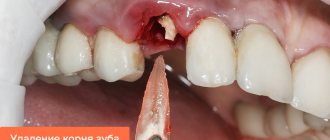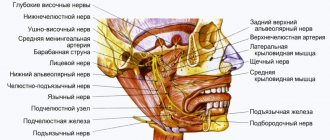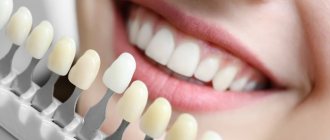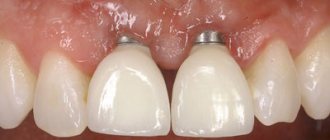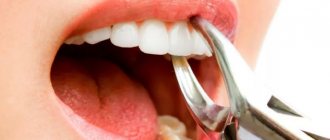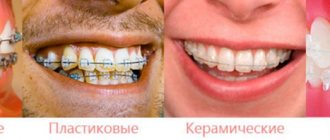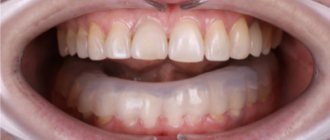Tooth loss is a disease in which, under the influence of negative factors, the integrity of the dentition is disrupted (due to the loss of one or more teeth). This disease is called edentulism.
Teeth are an important element of the human body. We lose them starting from childhood: healthy, strong teeth grow in place of lost milk teeth. Losing permanent teeth is a serious problem because a new tooth will not grow in the vacant space.
Causes of tooth loss
It is clear that teeth do not fall out on their own; this process is facilitated by various diseases of the periodontal tissue and gums. The reasons why a person may lose one or more teeth can be divided into objective and subjective. The first group includes phenomena that depend little on us or do not depend at all, the second group includes our erroneous actions or deliberate inaction.
Objective reasons
Chronic diseases are the main objective reason why seemingly healthy teeth begin to loosen and fall out: diabetes, cardiovascular diseases, stomach ulcers or duodenal diseases seriously affect the health of the oral cavity.
To better understand the nature of tooth loss, we will briefly talk about the negative effects of some chronic diseases. For example, diabetes is a disorder of blood sugar levels. Excess glucose leads to impaired blood supply to the gums, and due to impaired mineral metabolism, the enamel becomes thinner. A person with heart disease often takes medications that cause dry mouth, interfering with the normal functioning of the oral mucosa. Taking calcium antagonists (hypertension medications) can cause gum overgrowth.
One of the reasons leading to tooth loss is injury (as a result of an accident, while playing sports, during incidents). Often, after receiving a blow to the lower or upper jaw, you can lose one or more teeth.
Heredity is an important factor influencing the formation of a baby’s dental tissue in the mother’s womb. Poor nutrition and bad habits of the expectant mother can also affect the buds of teeth.
Subjective reasons
Failure to maintain oral hygiene leads to diseases of the gums and teeth. Lack of habit of regularly brushing your teeth to prevent pathogenic bacteria that penetrate under the gum tissue, forming tartar and plaque on the teeth.
The main enemies of the oral cavity are carbonated water and sugar, which, when combined, destroy tooth enamel and provide food for bacteria that destroy gums and dental tissue. They cause tooth decay and periodontitis, the most common diseases that occur in people who consume candy and soda.
Bad habits also make a destructive contribution to tooth loss - tobacco smoke contains a long list of toxic substances that do not add health to teeth and gums.
People cause some injuries to their teeth quite deliberately, for example, by opening bottle caps with their teeth. The fact that a tooth did not break due to such abuse does not mean that it will pass without a trace for him: in combination with other factors, everything can end in tooth loss.
Unfortunately, fears and worries about visiting the dental office and possible pain often repel patients from the opportunity to protect their teeth. No money? If a tooth falls out, the prosthesis will be much more expensive.
What to do if a filling falls out
Losing a filling is a common problem, but does not have any negative consequences other than the pain associated with the reopened nerve. If a temporary filling falls out at the most inopportune moment, try to contact your dentist as soon as possible. Given that the tooth cavity is opening up again, delaying the process of installing another filling can lead to aggravation of the problem, especially if food particles get into the tooth cavity.
Before starting treatment for a temporary filling that falls out, dentists determine the reason for the loss. Based on specific conditions, a certain material is selected, and treatment occurs using a certain technology. During the treatment, the remains of the previous filling are eliminated, the oral cavity is thoroughly processed, and then the damaged tooth is restored.
Until the dentist restores the lost filling and numbs the pain, the only possible measure the patient can take is not to place excessive stress on the damaged tooth. It is advisable to chew food on the other side of the jaw, and when brushing your teeth, treat the damaged area more carefully. It is also recommended to rinse your mouth more often to protect the damaged tooth from possible penetration of food debris with microbes and bacteria into it.
Statistics confirm that about 39% of people who complain about dental problems try to avoid visiting doctors. Fear of instruments and drills is quite justified, as is fear of possible discomfort when treating teeth and gums. However, it is precisely those patients who undergo systematic examination by dentists who avoid the biggest troubles throughout their lives. These include tooth loss.
Sign up for a free consultation >>
View prices
Making an appointment with a dentist
Diagnosis of tooth loss
If the first signs of disease are detected, and even more so of loose teeth. If the problem is ignored, the tooth will be lost forever. The doctor will ask you to take the necessary tests, take pictures, make a diagnosis, taking into account information about previous or existing diseases, and prescribe treatment. The main diagnostic methods are x-rays and, in some cases, dental computed tomography.
In the case when a patient suffers from a chronic disease, tooth loss is a consequence, the elimination of which will be an insufficient measure. The solution is comprehensive treatment of the underlying disease together with a specialized specialist.
Correction methods
Several years ago, the only method of correcting fused teeth was to remove them. Modern orthodontics offers more advanced ways to eliminate this anomaly, allowing you to leave the tooth intact.
As a rule, treatment depends on the type of pathology:
- in the first type, correction is carried out by careful grinding of the adjacent part of the tooth and subsequent restoration;
- in the second type, hemiresection is performed - that is, detachment and removal of the adjacent part without traumatic effects on the periodontium;
- the third type requires hemisection - detachment of the gum tissue and incision of the root part;
- with the quarter type, hemisection is carried out along the entire length of the teeth.
Stages of treatment
Correction of teeth fusion is carried out in several stages:
- The first stage is the removal of the secondary part of the tooth. When cutting off the upper part, conduction anesthesia is used, and in case of complete dissection, general anesthesia is used. Hemiresection is carried out using a diamond disc, and a two-week bandage is applied to the wound. Hemisection is a more traumatic procedure performed with a scalpel. Sutures are placed on the dissected mucosal flaps, which are removed after a week, and the tooth is splinted for two weeks;
- the second stage - orthodontic, begins two weeks after the separation of the teeth. Its goal is to restore normal occlusion. Most often it is corrected with a braces system.
Modern orthodontics makes it possible to treat fused teeth, restoring their normal appearance and preserving the pulp in 90% of cases.
Treatment of tooth loss
There are few methods for treating tooth loss: therapeutic and surgical intervention. In the first case, when the first symptoms are detected, the dentist removes tartar, eliminates the consequences of caries, prescribes antibiotics, antiseptics, and medications that strengthen the general immune system. Together with constant and proper oral hygiene, this method will help to cure most diseases associated with tooth loss.
To save the tooth, surgical intervention may be necessary - an incision in the gum, removal of tartar and dead tissue. The incision is sutured; the operation takes from 40 minutes to 2 hours, depending on the complexity and volume of work.
If a tooth is lost or the dentist was forced to remove it, the patient will need dental prosthetics. This work is performed by a highly specialized specialist - a prosthetist dentist. In place of a missing tooth, you can place an implant - an artificial tooth root with a crown, implanted into the jaw, or a bridge - a ceramic crown attached to adjacent teeth.
Consequences of dental fusion
The fusion of teeth is one of the forms of their incorrect development, which should not be taken lightly, as it can negatively affect the functioning of the entire dentofacial system.
The consequences of dental fusion can be:
- formation of abnormal occlusion;
- severe difficulty biting and chewing food;
- predominant mouth breathing, and, as a result, ENT diseases;
- diction disorders: lisp, unclear pronunciation of certain sounds, swallowing of words;
- psychological discomfort.
Prevention of tooth loss
It is easier to prevent a disease than to treat it - this truism is remembered more often when the disease has progressed far and complex treatment is required. Tooth loss can be prevented by following these recommendations:
- Maintain personal oral hygiene: brushing your teeth should be done at least twice a day, morning and evening;
- use dental floss to clean the spaces between your teeth from food debris;
- Visit your dentist regularly, even if your teeth are not causing concern;
- strictly follow your dentist’s recommendations for dental care and disease prevention;
- take care of chronic diseases (if any);
- protect your teeth from injury.
Do teeth fall out on their own?
Yes, they fall out if they are dairy. In this case, changing teeth can be accompanied in children by acute painful sensations, swelling of the gums and sensitivity of the enamel, and in some cases even itching. If you experience these symptoms, it is important to seek the advice of a professional dentist. At the same time, while waiting to see which tooth falls out first, you should not forget about the child’s adequate nutrition so that the body and teeth in particular continue to receive all the necessary vitamins and microelements.
When a baby tooth falls out, the wound may continue to bleed for 5-10 minutes. Simply give your child a sterile gauze or cotton swab to bite on the area where the baby tooth has fallen out. If bleeding continues for a long time, be sure to take your baby to the pediatrician to check blood clotting. The help of a dentist may also be needed when baby teeth complicate the eruption of permanent teeth. In this case, the teeth are forcibly removed.
What are the dangers of fused tooth roots?
Most often, the roots of primary molars grow together. In such cases, treatment is usually not carried out. By the age of 5-6 years, the tissues dissolve. This process must be monitored to prevent displacement of the permanent rudiments and to avoid malocclusion.
Often, dentists identify fused roots of wisdom teeth. They may not bother a person, but more often they cause discomfort. With this disorder, the risk of inflammation, the development of periodontal disease, and the formation of a cyst or granuloma increases.
Symptoms
Parents should be wary of the fact that their child’s baby teeth are not falling out. It is fused to the bone and cannot easily separate from the alveoli, as is normal. If the pathology is not detected and treated in a timely manner, the child’s jaw begins to develop incorrectly. The diseased tooth is located lower than the others, and the neighboring teeth are placed at an angle in relation to it. Problems with bite occur.
Another scenario is also possible. The baby tooth does not erupt completely and is delayed in its development. Because of this, the permanent tooth also cannot develop, and after the milk tooth falls out, it becomes fused with the jaw. This is how ankylosis of permanent teeth occurs. The final diagnosis is made after analyzing the results of a computed tomography scan.
Good to know. The service life of ankylosed teeth is completely different. They can last for decades or fall out, thinning out the dentition.


